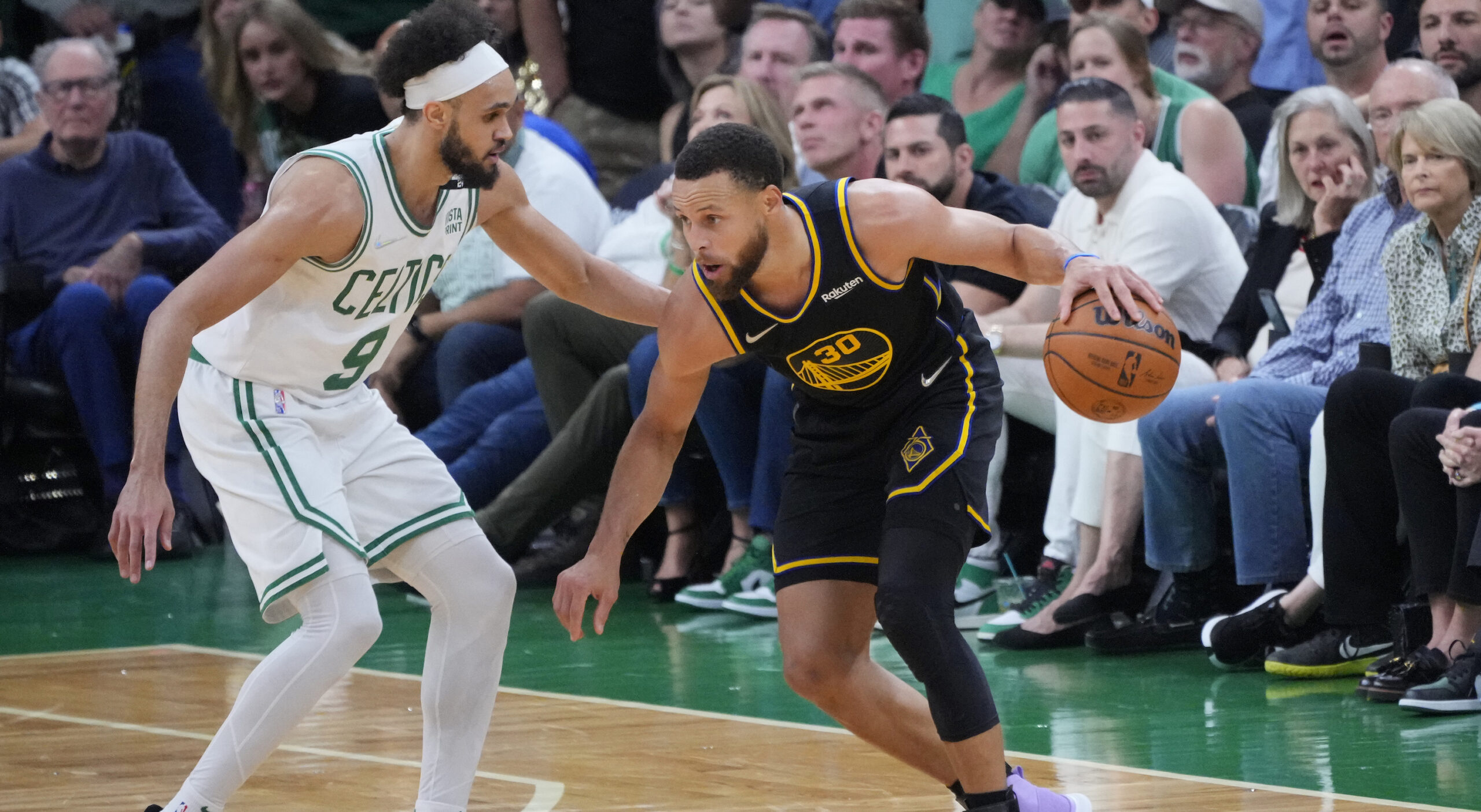
The Warriors outscored the Celtics 13-0 in clutch time in Game 4.
• Complete coverage: 2022 NBA Finals
Stephen Curry was not going to let the Warriors head back to San Francisco trailing 3-1 in the 2022 NBA Finals as he put on a performance for the ages at TD Garden in Boston on Friday night. Curry finished with 43 points, 10 rebounds, seven 3-pointers and four assists to lead the Warriors to a 107-97 win and a series tied at 2-2 as the Finals head back to California for Game 5 on Monday.
Let’s take a deep dive into all aspects of the box score:
Traditional
• Curry posted 40 points or more for the seventh time in his playoff career, and second in the NBA Finals – he scored a playoff career-high 47 points in Golden State’s Game 3 loss to Toronto in the 2019 Finals. The Warriors are now 5-2 when Curry scores 40 or more in a playoff game.
• Andrew Wiggins scored 17 points and grabbed a game-high and career-best 16 rebounds for the Warriors. Wiggins’ previous career high in rebounds in any game – regular season or playoffs – was 11, which he hit three times this season.
• Steve Kerr made a change to the starting lineup by going with Otto Porter Jr. over Kevon Looney. Porter finished with just two points in 15 minutes, while Looney still played 28 minutes off the bench and finished with six points, 11 rebounds and a game-high plus-21.
• Draymond Green continued to struggle on offense, scoring just two points on 1-for-7 shooting, but he did dish out a game-high eight assists. For the series, Green has accumulated more fouls (18) than points (17).
• Jayson Tatum finished with 23 points, 11 rebounds and a team-high six assists. However, he shot just 8-for-23 (34.8%) from the field, including 4-for-15 (26.7%) on 2-point shots and committed a game-high six turnovers.
• Jaylen Brown finished with 21 points on 9-for-19 (47.4%) shooting, which was the best shooting performance of the night for the Celtics outside of Robert Williams III’s 3-for-3 game on the inside.
• In Boston’s two wins in this series, it has shot 50.6% (Game 1) and 48.3% (Game 3) as a team, respectively. In their two losses in the series, the Celtics have shot 37.5% (Game 2) and 40% (Game 4). Boston has been held below 100 points only four times this postseason: Game 1 vs. Milwaukee, Game 5 at Miami and their two losses to Golden State in the Finals.
• Golden State’s bench – Looney, Gary Payton II, Jordan Poole and Nemanja Bjelica – combined to score 25 points on 11-for-22 shooting as they bested the Boston bench by six points. Boston’s reserves – Derrick White, Grant Williams and Payton Pritchard – combined for 19 points (16 of which came from White alone) on 5-for-19 shooting.
Do the Warriors need 40-plus points from Stephen Curry to win the Finals?
• The first three games of the series featured only 11 total seconds of clutch time – score within five points in the final five minutes of the fourth quarter or overtime – and that came in Game 1, when Al Horford made a 3-pointer with 4:49 to play in the game to put Boston up by six. The game never got within five again as the first three games were decided by 12 points or more. But Game 4 finally delivered some clutch play. When the game hit the five-minute mark to activate clutch time, Boston led 94-90; the Warriors would score the next 10 points to lead 100-94 and deactivate clutch time with a six-point lead. Al Horford’s 3-pointer with 1:32 to play – which proved to be Boston’s only points in the final five minutes brought the margin back to within five and reactivated clutch time. Golden State responded with a Looney layup and a Curry free throw to once again make it a six-point game with 48 seconds to play.
• In addition to winning clutch time in the fourth quarter, the Warriors also maintained their stranglehold on the third quarter as they outscored the Celtics 30-24 to increase their third-quarter margin for the series to plus-49. The Warriors also cut into Boston’s fourth-quarter margin, which was plus-40 entering Game 4 and now stands at plus-31 following Friday’s game.
• For the series, Golden State has outscored Boston by a cumulative total of one point (422-421). The Warriors have made four more 2-point shots (90-86), while the Celtics have made seven more free throws (57-50). The teams are tied from beyond the arc with 64 made 3-pointers each.
Advanced
• Although Kevon Looney did not start the game, the Warriors posted their best offensive rating (125.0) and defensive rating (89.1) during his 28 minutes on the court.
• The Warriors assisted on only half of their made field goals in Game 4, which is not only their lowest assist percentage of the Finals, but is also their lowest mark of the entire postseason. In fact, the Warriors had just one game all season with a lower assist percentage (47.8% vs. LAL on March 5).
• In Jaylen Brown’s 40 minutes on the court, the Celtics posted an offensive rating of 112.7, which is 1.2 points higher than Boston’s playoff average. However, in Brown’s eight minutes off the court, Boston’s offensive rating plummeted to 44.4.
• Through the first four games of the series, Golden State has won the two games played at the fastest pace: Game 2 (97.50) and Game 4 (96.00), while Boston has won the two games played at the slowest pace: Game 1 (93.50) and Game 3 (94.50).
Miscellaneous
• The trend that the team that wins the points in the paint also wins the game held true in Game 4 as the Warriors finished with a 38-32 advantage in that zone. Boston’s Jaylen Brown led all players with 12 points in the paint, while Stephen Curry led the Warriors with 10, followed by Andrew Wiggins at eight.
• The Warriors finished Game 4 with a 16-11 advantage in offensive rebounds and a 19-12 win in second-chance points. Andrew Wiggins led all players with seven of his 17 points coming on second chances. Robert Williams III led the Celtics as five of his seven points came on putbacks.
• The Warriors finished with a 19-17 advantage in points off turnovers for the second straight game in Boston. The Warriors have scored 52 points off Boston’s 35 turnovers in their two wins, and scored just 29 points on Boston’s 25 turnovers in their two losses.
Scoring
• Stephen Curry shot 7-for-12 (58.3%) on 2-point shots and 7-of-14 (50%) on 3-point shots in Game 4. He not only made the same number of 2s and 3s, he was also assisted at the same rate on both shot types (42.9%).
• Jayson Tatum attempted nearly two-thirds of his shot attempts from 2-point range (65.2%), but those attempts only produced 34.8% of his points as he finished just 4-for-15 on 2-point shots and 4-for-8 on 3-point shots. Tatum’s four 3-pointers accounted for more than half his points (52.2%).
Full Focus: Stephen Curry drops 43 on Celtics, Warriors even Finals
• Otto Porter Jr. has yet to attempt a 2-point shot in the Finals as all 11 of his shot attempts have come from 3-point range. Porter is shooting 7-for-11 from deep for the series after going 0-2 in Game 4.
• Andrew Wiggins scored 47.1% of his points in the paint, which was the highest percentage of any player not playing power forward or center.
• Both teams made 15 3-pointers in Game 4. The Celtics assisted on 93.3% of their 3-pointers as just one of the 15 was unassisted, which belonged to Tatum. The Warriors assisted on 66.7% of their 3-pointers as five were unassisted, including four by Curry and one by Jordan Poole.
Usage
• Stephen Curry led all players in usage rate in Game 4 at 35.9% — his highest usage rate of the series. So far this postseason, the Warriors are 6-0 when Curry posts a usage over 35%.
• While Curry finished nearly 36% of the Warriors’ offensive possessions while he was on the court, he scored nearly 46% of the Warriors points in his 41 minutes on court.
• While Draymond Green had another tough shooting performance (two points on 1-for-7 from the field), he did account for more than half of Golden State’s assists (53.3%) and steals (57.1%) in his 33 minutes on court.
• Jayson Tatum led the Celtics in usage rate at 30.5%, followed by Jaylen Brown (23.5%), Marcus Smart (22.4%) and Derrick White (21.3%). Tatum’s top two usage games in the series have both been Celtics losses.
Four Factors
• The Warriors outshot the Celtics in terms of effective field goal percentage 52.2% to 48.8%. There is a huge disparity in eFG% between Boston’s wins in the series (59.2%) compared to their losses (47.9%). Meanwhile, Golden State actually has a higher eFG% in their two losses (55.4%) than their two wins (53.1%).
• Boston has finished with a higher free throw rate in three of the four games in this series. After Game 4, the Celtics have attempted 11 more free throws than the Warriors and made seven more.
• The Warriors dominated the glass in Game 4, finishing with a 38.5% offensive rebound rate – their highest mark of the Finals. Kevon Looney (14.3%) and Draymond Green (13.5%) led the way for the Warriors on the offensive glass, while Robert Williams III (12.1%) was the only Celtic to finish higher than 6.1%.
Player Tracking
• Stephen Curry shot the ball better when he was contested (9-for-14, 64.3%) than when he was left uncontested (5-for-12, 41.7%) in Game 4. Curry nearly made as many contested shots (9) as the Celtics did as a team (11).
• It’s often said that great offense beats great defense. The Game 4 numbers show it as Golden State shot 52.6% (20-38) as a team on contested shots, while the Celtics shot just 39.3% (11-28).
• Boston held the edge in shooting on uncontested looks – 40.4% (23-57) for the Celtics to 37.7% (20-53) for the Warriors – but it was not enough to make up for Golden State’s huge advantage on contested shots.
Steph Curry’s electric 43-point performance in Game 4 draws rave reviews.
• Jayson Tatum scored a team-high 23 points but needed 23 shots to get those points. Similar to Curry, Tatum shot better on contested looks (3-for-8, 37.5%) than he did on open looks (5-for-15, 33.3%), but was under 40% on both.
• No player was on the move more than Klay Thompson in Game 4 as he traveled just under three miles on the court with a game-high 2.97 miles. Thompson played the third-most minutes of any player in Game 4 (40:49) but covered more distance than his teammate Andrew Wiggins (2.95 miles in 43:26) and top opponent Jayson Tatum (2.91 miles in 42:40).
Hustle
• During the regular season, the Warriors averaged 10 screen assists per game (7th in NBA). In the first three rounds of the playoffs leading into the Finals, they averaged 9.3 screen assists (3rd in NBA). Through four games of the Finals, Golden State is averaging 12.3 screen assists, which are producing 33 points per game. In Game 4, the Warriors had 14 screen assists for 38 points – the top two marks of the series.
• The two Kia Defensive Player of the Year winners in this series – Draymond Green (2016-17) and Marcus Smart (2021-22) – led their respective teams in deflections in Game 4. Green finished with a game-high six, while Smart had five.
• The teams tied in loose balls recovered as every 50-50 ball is critical in the Finals. No play may have demonstrated that more than Jayson Tatum’s dive and slide across the sidelines to try to save a ball from going out of bounds. He didn’t get the save (or the loose ball recovered stat) but it was one of the top hustle moments of the night.
• Boston doubled up the Warriors on box outs in Game 4, 12-6. Al Horford led Boston with four box outs (all defensive), while Draymond Green led the Warriors with three (also all defensive). For the series, the Celtics hold a 45-30 edge in box outs.
Defense
• Kevon Looney (7-for-13, 53.8%) and Jordan Poole (3-for-4, 75%) were the only two Warriors defenders to allow their matchups to shoot over 43 percent from the field in Game 4.
• Andrew Wiggins defended more shots than any player in Game 4 (22) and held his matchups to 9-for-22 (40.9%) shooting from the field, including 5-for-14 (35.7%) on 2-point shots.

Andrew Wiggins held his opponents to 5-for-14 (35.7%) on 2-point shots in Game 4.
• Jayson Tatum held his matchups to 5-for-15 (35.7%) shooting from the field and led all players with three blocked shots.
• In addition to his 18 points and four 3-pointers on offense, Klay Thompson held his defensive matchups to 30.8% shooting (4-13) from the field and 33.3% (2-6) from beyond the arc.
• Draymond Green and Marcus Smart each allowed six field goals made to their matchups, while also recording four steals. Green’s matchups shot 6-for-14 (42.9%) from the field and 1-for-5 from 3-point range. Smart’s matchups shot 6-of-16 (37.5%) and 2-of-9 (22.2%) from long range.
Matchups
• In each of the first three games of the Finals, Marcus Smart was matched up with Stephen Curry for the most minutes of any Celtic, followed by Derrick White each time. In Game 4, that flipped as White defended Curry for a team-high 5:02 and Smart defended Curry for 4:37. Curry scored 10 points on 4-of-7 shooting against White compared to four points on 1-of-4 shooting (0-of-2 from three) against Smart. Smart allowed only 9.3% of Curry’s points while defending him for 29.5% of Curry’s offensive matchup time.
• A key to Smart’s defense on Curry is not just keeping Curry from shooting a high percentage, but also limiting his shot attempts. While Curry had just four shots in 4:37 against Smart, he had six shots against both Jayson Tatum (in 2:36) and Al Horford (in just 1:33) and made half of those attempts for 16 of his points.
• In addition to his 17 points and career-best 16 rebounds, Andrew Wiggins also served as the primary defender on Jayson Tatum for a team-high 9:36 (55.1% of Tatum’s total offensive matchup time). Wiggins held Tatum to 12 points on 5-for-13 (38.5%) shooting. Tatum finished with as many field goal attempts as points (23 each) and Wiggins’ defense allowed just 12 points on 13 shots.
• Three of Tatum’s turnovers came in one minute of matchup time against Nemanja Bjelica, who held Tatum scoreless on 0-for-2 shooting.
• Klay Thompson seven points in 7:07 of matchup time against Jaylen Brown. Thompson was 2-for-2 on 2-point shots and just 1-for-3 on 3-point shots while being defended by Brown.
• The Warriors split the assignment of defending Jaylen Brown evenly between Draymond Green (5:11 of matchup time) on Klay Thompson (5:07 of matchup time). Green allowed seven points on 3-of-8 shooting (0-of-2 from three) as well as two assists and one turnover. Thompson allowed five points on 2-of-5 shooting (1-of-2 from three), zero assists and one turnover.



